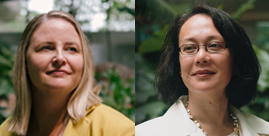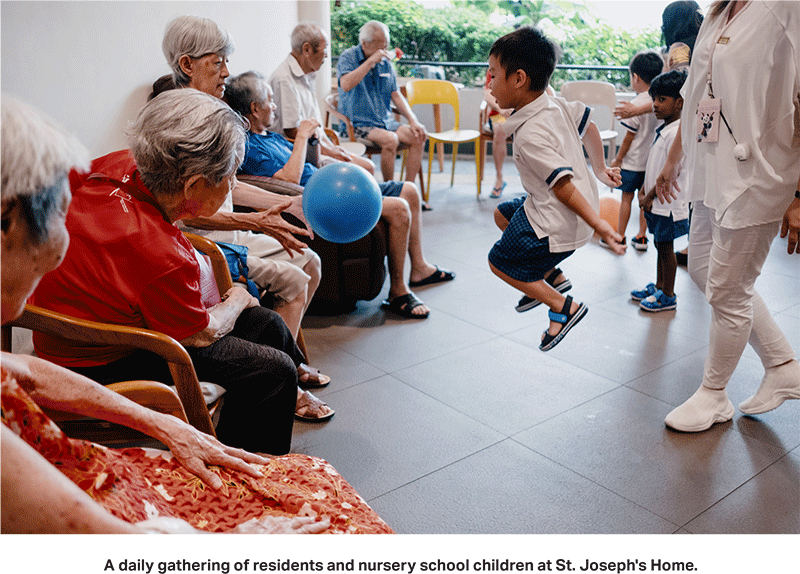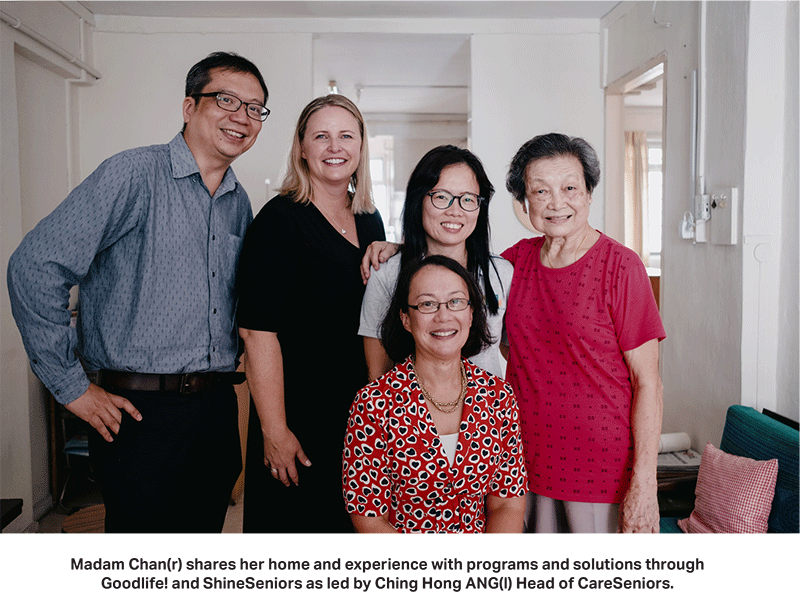
By Debra Whitman and Lina Walker
Download PDF
It was midnight when we arrived in the tiny island nation of Singapore, but we could barely wait to start exploring — yes, the beautiful country that it is, but also something with much bigger implications.
Our AARP team had flown almost 10,000 miles to witness how Singapore has become a leader of longevity, dedicated to meeting the needs of its rapidly aging society. We wanted to see for ourselves what the nation is doing and what we, and the rest of the world, might learn from its ideas and experience.
Over the next week, we were rewarded with unforgettable sights, sounds, and tastes as we explored this fascinating nation in the Pacific. Part of that, of course, was experiencing the culture, and various aspects of a nation’s daily life. Our mission-related experience, it turned out, was every bit as rich, and in fact the two kinds of experiences merged more often than not. We visited a playground where young children and older adults play together on see-saws and merry-go-rounds, both designed to meet each group’s different needs. We met with older individuals who told us about their lives as we ate the delicious lotus paste-filled mooncakes they served us.

We toured Kampung Admiralty, an age-inclusive, livable community that features a public gathering and shopping space on the ground level, a medical center on the middle floors, and apartments for older adults on the top floors — all awash in lush greenery, including rooftop garden plots for residents to cultivate.
We also met with an array of government officials to talk about Singapore’s highly detailed Action Plan for Successful Aging, which the country is now implementing after years of preparation. We came away filled with not only ideas, but the inspiration to build on them.
Facing the challenge
One of Singapore’s hard realities is that its 5.6 million residents are packed into a space much smaller than Rhode Island, the smallest US state by land area, which has a population of just over 1 million. But what Singapore lacks in space it makes up in vision — an expansive vision for inclusion and proper support that considers its whole population, even as the nation navigates its own changing demographic and economic realities.
To its credit, Singapore has long understood the need to prepare for longevity. It is among the fastest-aging high-income societies in the world, and its older population is projected to double by the end of this decade. Its residents are living longer than ever (it already boasts the world’s longest life expectancy, at 84.8 years) and its birth rate is exceptionally low — lower than that of the United States or even Japan, the country known for leading all others in the global aging trend.
Meanwhile, the family caregiving dynamic is evolving. As is the case in the United States, an increasing number of Singapore’s older adults are living alone, and the ratio of younger family members to support them is declining. In addition, Singapore is confronting both a shrinking labor force and changes in the job market, including the need for new skills.
Action plan for graceful aging
There is no question that Singapore has prepared for the demographic trend. Back in 2010, Singapore Prime Minister Lee Hsien Loong told AARP’s International Journal that his country was taking the challenge of aging very seriously — and, in fact, had already been doing so for a long time. “Since the 1980s, we have been putting in place health care, social security and housing policies to anticipate and head off future problems,” he noted at the time. After those measures, Prime Minister Lee implemented another milestone action in 2009, when he appointed a senior cabinet minister to coordinate aging issues across all government agencies. As part of those efforts, Singapore formed a ministerial committee on aging, bringing together different government agencies to coordinate government policies and programs in a holistic manner. Priorities included personal responsibility, employment opportunities during all adult life stages, and communities that support active aging.
In 2015, Singapore unveiled its multipronged action plan to promote “confident aging” and active lives — that is, a strategy aimed at changing views about aging and empowering individuals to stay connected to their families and community. The action plan encompasses a range of life facets, focusing on such areas as wellness, employment, housing, retirement security, education, social inclusion, and vulnerable older adults.
Currently in its implementation phase, the plan is designed to work on three distinct levels — individual, community, and national.
Individual level: a lifetime of growth-and-development opportunities. In our travels around the country, we saw firsthand how Singapore is taking innovative steps to foster lifelong learning and lifelong employment. We met with Deputy Chief Executive Tan Wee Beng to learn about a fascinating education program that empowers people to “own their future” and continue realizing untapped potential through all life stages. The program, called SkillsFuture, helps individuals of all ages maintain or build new skills and abilities required to hold jobs in a changing workplace.
Singapore also offers a broad range of subsidized courses available to individuals ages 50 and older through the National Silver Academy — a network of institutions committed to lifelong learning and making courses accessible such as through online platforms or through the community.
Community level: A village for all. Singapore’s goal is to implement the concept and framework of a kampong — or village — that supports people of all ages and backgrounds. We witnessed the kampong concept in concrete form when we went to the Whampoa neighborhood and visited the home of a woman who cares for her two grown sons, both of whom have physical and developmental disabilities that require full-time care. She explained how a local service center offers critical support, enabling her to maintain her own health while providing the care her sons require. The community program, funded by the Tsao Foundation (whose work focuses on “keeping a healthy, functional and happy person” as individuals age), recognizes that enabling all people to live securely and as independently as possible requires many supports including primary care, long-term services and supports, transportation, and access to shopping and other necessities.
“The future of aging is how we design it,” says Chairman and Founding Director Mary Ann Tsao. “It’s not as you saw in the past.”
National level: A country of inclusion. The vision for the entire nation of Singapore is “a city for all ages,” where all residents can age gracefully with support from programs for active aging and health care.
For the national-level vantage point, we met with Minister for Health Gan Kim Yong, whose ministry houses the Ageing Planning Office. Minister Gan views Singaporeans’ increasing longevity as both a gift of time and an opportunity. Embracing policies that promote independence, engagement, and inclusion, he explained, can create a movement in which Singaporeans “live to learn and learn to live.” Public-private partnerships are moving the nation closer to that goal, he said.
We also learned how Singapore’s planners are thinking creatively to make health care more accessible, and even more convenient. To give one novel example, when taxi drivers bring their vehicles in to a central maintenance facility for service, they can also get a checkup for themselves — by seeing a doctor right on site.
In another example, SHINESeniors is deploying technology to help people age more safely and avoid the dangers of isolation. The telehealth initiative combines in-home sensors with data analytics to discreetly monitor residents’ movements and send alerts if something looks amiss. Interestingly, in a wrinkle that is still being fine-tuned, to hold down costs, alerts go to community monitors rather than the health care system. Our hosts told us they are still trying to devise the best system for responding to alerts, which can occur at any hour of the day or night.

Parallels across the Pacific
As we made the rounds on our enlightening trip, we could not help but notice parallels between Singapore’s approach to its aging population and AARP’s Disrupt Aging message. Disrupt Aging highlights the promise and possibilities that age, experience, and living longer bring to all of society; it is driven by the awareness that people can have productive, meaningful, and purposeful lives no matter their age.
In a similar vein, behind Singapore’s Action Plan for Successful Aging is the understanding that people can learn, grow, develop, and flourish throughout their lives.
AARP understands that the United States and many nations around the world are aging fast. Singapore is one country to show leadership in facing the challenge ahead by elevating the issue as a policy priority, crafting a comprehensive plan to address its demographic changes, and developing innovative solutions.
To be sure, our visit to this small nation with a big vision illuminated in vivid detail how careful planning and design can result in meaningful improvements in the everyday lives of people. Programs that come out of that kind of intentional development can enable people to age with dignity, independence, and security.
In light of the global aging trend, the world must learn from other countries’ successes and solutions. Clearly, the world has something to learn from Singapore.
Suggested Citation
Whitman, Debra and Walker, Lina. 2020. "Singapore: An Island Nation with a Big Vision for Aging." AARP International: The Journal, vol. 13: 66-73. https://doi.org/10.26419/int.00036.007
about the authors
As AARP’s chief public policy officer, Debra Whitman, leads policy development, analysis and research, as well as global thought leadership supporting and advancing the interests of individuals age 50-plus and their families. She oversees AARP’s Public Policy Institute, AARP Research, Office of Policy Development and Integration, Thought Leadership, and AARP International.
Lina Walker serves as the vice president of health security in AARP’s Public Policy Institute, where she leads a team of senior health policy and health services researchers. She has spent nearly 20 years conducting research and publishing on health care and retirement issues.